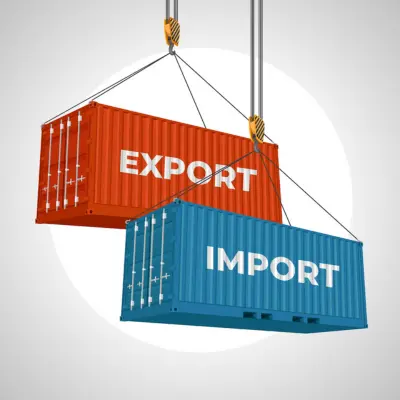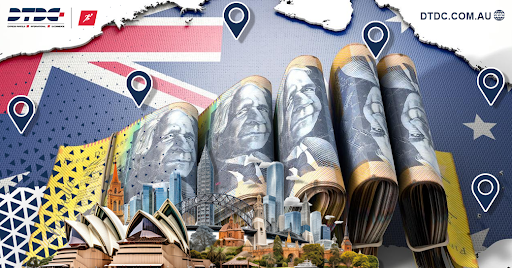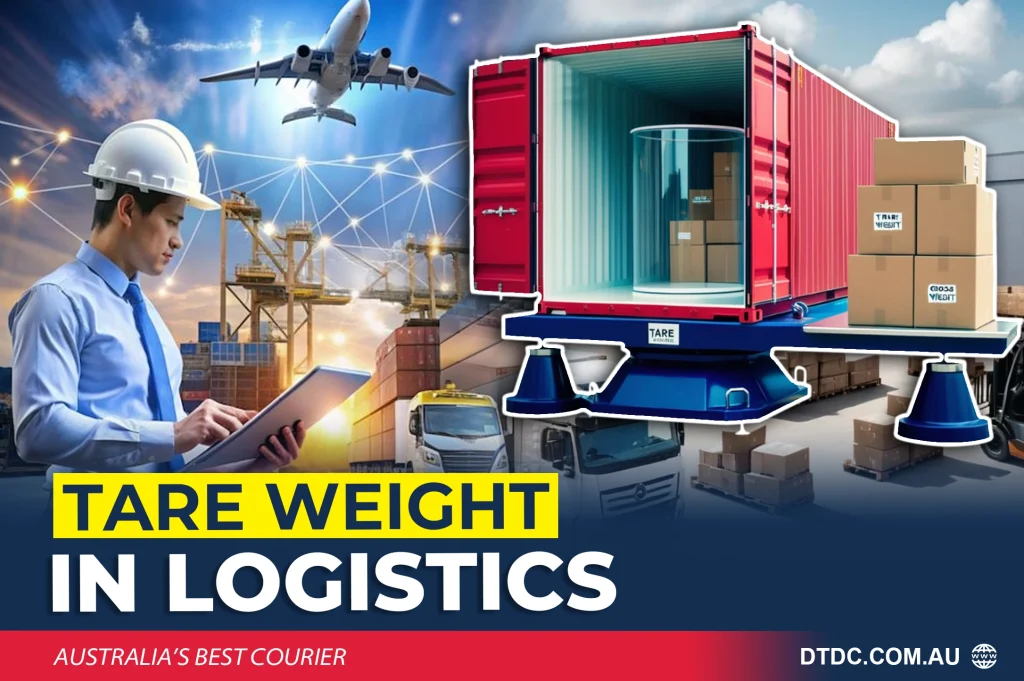One of the overlooked factors in logistics is the tare weight. Even many people within the industry are not aware of this concept. But it matters, and often it can lead to huge cost savings for your shipments.`
Enterprise owners should know such concepts so they can better understand where money is being spent. Through this blog, let us get more familiar with this concept and understand its importance for importing and exporting.
What is Tare Weight?
Tare weight is the weight of an empty container, packaging, or vehicle that has been officially recorded. Logistics companies record it to ensure that there is a standard for these measurements, and they can be used for calculating shipping costs.
| Container Type | Tare Weight (kg) | Max Gross Weight (kg) | Max Payload (kg) |
| 20ft (Standard) | 2,200–2,400 | 24,000 | 21,600–21,800 |
| 40ft (Standard) | 3,700–3,900 | 30,480 | 26,500–26,800 |
| 40ft (High Cube) | 3,800–4,200 | 30,480 | 26,200–26,600 |
This is an important metric in the calculation of gross weight. Freight officials calculate gross weight as the sum of net weight and tare weight. Net weight of the shipment refers to the weight of the shipment alone.
The gross weight represents the total weight, including the goods, packing materials, and the weight of the container. Understanding the weight of tare eventually leads to the importance of accurate measurement for ensuring safety and cost control in logistics.
The Importance of Tare Weight in Logistics
In the logistics sector, the accuracy of the weight of the shipment is quite important. Logistic companies, regulators, and authorities strictly maintain these standards due to their importance in maritime safety and weight limits.
Failing to meet these standards will result in penalties or delays to the shipments during the customs procedures, which eventually result in higher costs. Additionally, they also impact inventory control, as in most cases, shipments are carried along with containers.
Despite all of this, nearly 20% of containers handled at the ports fail to comply with the SOLAS Verified Gross Mass standards. Port officials are able to detect such violations because of the use of the weight of tare in container movement standards.
Components of Tare Weight
In an actual sense, tare weight is not just the weight of the containers; it also includes several other components. Some of the common elements are
- Shipping containers: Large containers used to store shipments while transporting them through cargo ships.
- Pallets: A flat platform used to store or move around goods.
- Packaging materials: Cardboard wraps, bubble wraps, and other materials used for safely packaging the goods.
- Trailers: The unloaded weight of the vehicles used for goods transportation.
- Rail weight wagons: Weight of the empty rail cars.
- Air cargo unit load devices: Lightweight structures made from aluminium or composites, specifically made to transport air cargo.

With these components as reference, let’s see how it impacts the key players in the market, such as importers and exporters.
Implications for Importers and Exporters
For importers and exporters, the weight of tare directly influences the following areas:
- Customs Duties and Tariffs: Since tariffs are often based on net weight, knowing the unloaded weight avoids overpaying taxes.
- Compliance with SOLAS: The Safety of Life at Sea (SOLAS) convention requires shippers to verify gross mass, which includes the unloaded weight of containers.
- Cost Efficiency: By accurately recording unloaded weight, exporters prevent inflated freight invoices.
- Cargo Planning: Importers rely on the weight of tare to maximise container utilisation without breaching weight limits.
DTDC Australia provides detailed documentation and accurate tare weight, which helps importers and exporters to avoid delays and extra charges. Similar to importers and exporters, couriers and freight companies also depend on precise measurement.
Couriers and Freight Companies
The table below showcases how different package types contribute towards the gross weight of the package.
| Package Type | Gross Weight | Packaging Share | Net Weight |
| Small Box (E-commerce) | 1.8 kg | 0.4 kg (22%) | 1.4 kg |
| Medium Box (Courier) | 5.0 kg | 1.2 kg (24%) | 3.8 kg |
| Air Cargo ULD (Bulk Load) | 1,500 kg | 90 kg (6%) | 1,410 kg |
It is evident that these small differences can make a significant impact, especially in couriers of high volume. Let’s look at different ways in which tare acts in the case of couriers and freight companies.
- Parcel Billing: In small package shipping, carriers calculate charges based on dimensional weight instead of the actual weight. Tare weight helps balance the billing process by giving a standard measure.
- Fleet Optimization: Knowing the empty weight of trucks ensures they are not overloaded once goods are added.
- Efficiency in Last-Mile Delivery: Couriers also use it to estimate how many parcels can be loaded onto each vehicle.
- Transparency with Customers: Accurate measurement allows couriers to provide fair and competitive pricing.

For example, a courier handling thousands of packages in a day can calculate how much packaging contributes to the weight of tare, and this can help in avoiding billing disputes.
Tare Weight vs Curb / Kerb Weight: What Is the Difference?
Readers often confuse the terms tare weight and curb/kerb weight, but they have different applications:
Tare Weight: Refers to empty containers, packaging, or transport units used in shipping and logistics.
Curb/Kerb Weight: Refers to the weight of a vehicle, including all fluids such as oil, fuel, coolant, without the passengers and cargo.
In logistics, the weight of tare is more relevant for freight billing and cargo calculations, while curb weight is used for vehicle regulations and load safety.
How To Check Tare Weight for Shipments
There are several ways to determine the weight of tare, depending on the cargo type. Let us look at some of the ways.
- Manufacturer’s Specifications: Containers, ULDs, and vehicles usually have unloaded weight stamped on a metal plate or label on their bodies.
- Weighbridges: Modern Truck measuring equipment has technology to measure gross weight and the weight of tare directly from the fully loaded trucks.
- Digital Logistics Systems: Freight management software automatically records it. These systems can facilitate 30% faster customs clearance with accurate measurements.
- Customs and Shipping Documentation: Bills of lading and packing lists often include the weight of tare details.
To better understand these concepts, let us look at real-world applications of unloaded weight across different shipping methods.
Practical Examples in Global Trade

To see why tare weight matters in logistics, let’s look at some real-world cases of the application:
- Sea Freight Example: A 40ft container has an unloaded weight of 3,750 kg. If gross weight is 28,000 kg, the net cargo weight is 24,250 kg. Tare weight is 12% to 15% of gross weight.
- Air Freight Example: An air cargo ULD weighs 90 kg. If the gross weight is 1,500 kg, the net cargo weight is 1,410 kg. Air freight has a lower tare ratio of 5% to 8%.
- Courier Example: A package weighs 5 kg gross. If the packaging accounts for 1.2 kg, the net product weight is 3.8 kg. Tare contributes to nearly 20% to 25% of gross weight.
These scenarios highlight how the weight of tare impacts both the logistics of large-scale and small-scale companies. Looking ahead, as supply chains are becoming more complex and global trade is growing in volume, it will remain a key metric.
Future Trends
In logistics, tare weight is far more than the metric used to indicate the weight of an empty container. With e-commerce parcels expected to reach 256 billion in 2027, concepts like tare weight will play an even greater role in logistics.
For importers and exporters, accurate weight of tare reporting reduces costs and avoids delays at customs. A trusted logistics partner like DTDC Australia, known for its expert handling of tare weight, transparent pricing, and customs clearance services, can facilitate this.
Ready to experience streamlined shipping with accurate weight handling and competitive pricing? Contact DTDC Australia today to learn more.
Frequently Asked Questions (FAQs)
1. What is the difference between tare weight and GVM?
GVM refers to Gross Vehicle Mass, which indicates the maximum total weight of a fully loaded vehicle. On the other hand, tare weight is the weight of an unloaded vehicle.
2. What is the tare weight of a truck?
Unloaded weight of trucks varies depending on the size of the truck, which can be broadly classified as:
- Light trucks: 2,000 to 4,500 kg
- Medium rigid trucks: 5,000 to 12,000 kg
- Heavy prime movers: 12,000 to 18,000+ kg (With trailer, it can even go above 22,000 kg).
3. How to calculate tare weight?
Tare weight can be found from the vehicle information provided by the vehicle manufacturer. A weighbridge can also be used to find it. Or else if gross weight and net weight are available, then it can be found by the equation:
Tare weight = Gross Weight – Net Weight
4. How is tare weight different from gross weight and net weight?
- Gross Weight = Cargo weight + Packaging/Container (Tare) weight
- Tare Weight = Empty container/packaging weight
- Net Weight = Gross Weight – Tare Weight
5. Where can I find the tare weight of a container?
Most shipping containers have a metal plate called the CSC plate on the door displaying the tare weight. It can also be found in manufacturer specifications or shipping documents.
6. How do couriers use tare weight in billing?
Couriers consider the tare weight of packaging materials to ensure that the customers are charged for the actual product weight and not inflated by heavy packaging.
8. Can tare weight affect customs duties?
Yes. Import duties and tariffs are usually calculated based on net weight. Overstating the tare weight can lead to compliance issues, while understating the gross weight can lead to extra charges.













